The year was 1996. A rancher on Hanson Ranch in the badlands of eastern Wyoming introduced a group of creation scientists to a site containing an unusually large number of dinosaur fossils. They were all buried in one location. The scientists didn’t know it at the time, but they would be studying the Hanson Ranch Bonebed for the next two decades and onward in an attempt to solve the mystery of how the dinosaurs died and became buried here. Four of the scientists currently involved in fossil excavations at the site, Keith Snyder, Matthew McLain, Jared Wood, and Arthur Chadwick, summarized the past 20 years of research in a paper published in PLOS One in early 2020.1
What you are about to read is but a brief summary of their work and how the Hanson Ranch Bonebed confirms one of the most cataclysmic events recorded in the Book of Genesis.
The following is a summary of “Over 13,000 elements from a single bonebed help elucidate disarticulation and transport of an Edmontosaurus thanatocoenosis” by Keith Snyder and et al., and of the surrounding discussion and research pertaining to it. The views expressed do not necessarily reflect those of New Creation.
Not Your Average Bonebed
The HR Bonebed contains a menagerie of organisms, many of which are unusual to us in the present. But others are very similar to those found alive today. Discovered fossils at the site include freshwater and brackish-water mollusks, snails, ray-finned fish, elasmobranchs (the group containing sharks, stingrays, and skates), crocodiles, turtles, and a few mammal teeth and bird bones. But what makes the HR Bonebed stand out is that it contains an estimated 10,000 to 25,000 individual dinosaurs.2 These include Triceratops, Pachycephalosaurus, and an assortment of theropods (meat-eating dinosaurs), ranging from Tyrannosaurus to the much smaller dromaeosaurs (“raptors”) and troodontids. However, more than 95% of the dinosaurs represented at the HR Bonebed actually come from just one species: a large hadrosaur (“duck-billed” dinosaur) called Edmontosaurus annectens.
The recent summary of HR Bonebed research by Keith Snyder and his team narrowed their focus to 13,000 elements (including about 8,400 identifiable bones) that they have already excavated in 506 square miles of the recovery area between 1996 and 2016. All of these fossils are currently housed at Southwestern Adventist University in Keene, Texas. You can view them all online at http://fossil.swau.edu.
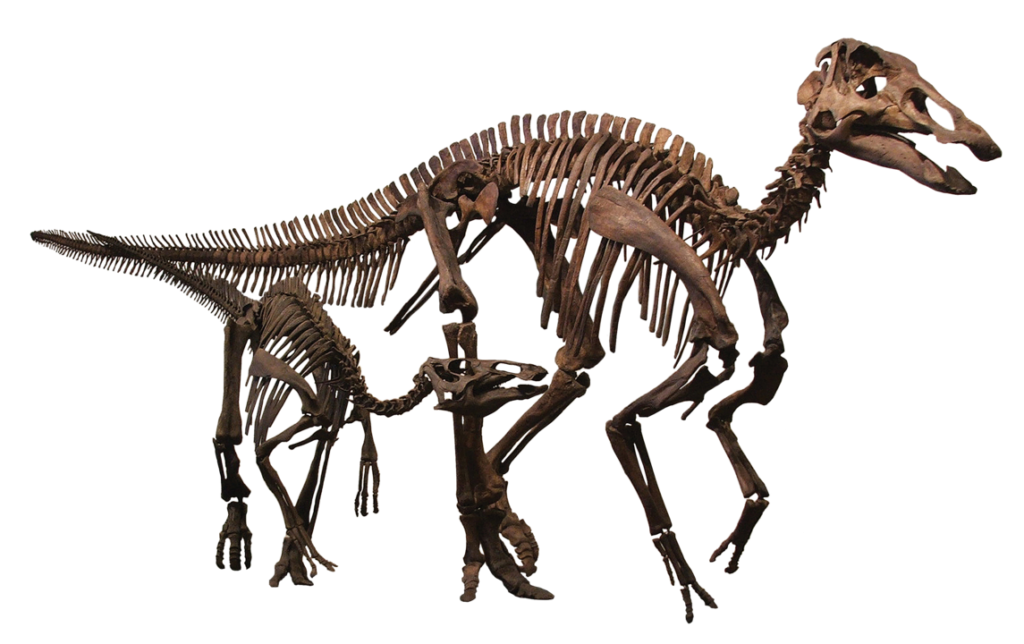
Edmontosaurus annectens
- Very Common
- 30-40 feet long (9-12 meters long), weighed 4-10 tons (4-9 metric tons)
- Herbivore, eating conifer needles & twigs, seeds & fruit
- Upper Cretaceous
By MCDinosaurhunter – Own work, CC BY-SA 3.0, https://commons.wikimedia.org/w/index.php?curid=33465209
Death in Numbers
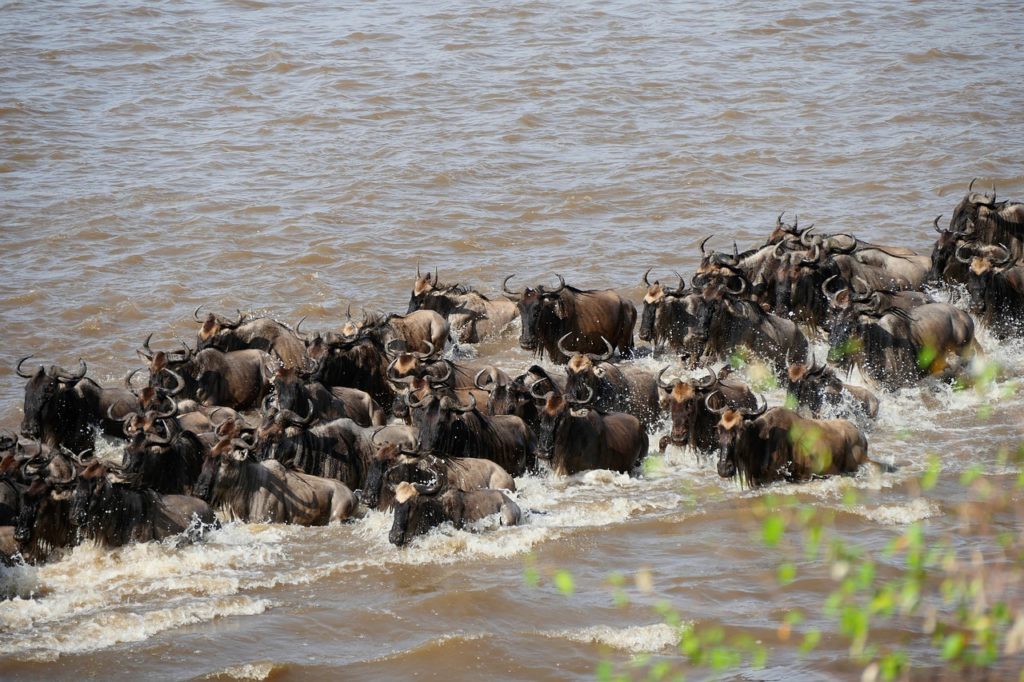
How did so many Edmontosaurus and other animals end up buried together like this? To answer this question, we need to understand taphonomy, the study of what happens between the time an organism dies and when it either decays or becomes fossilized. Old-earth paleontologists tend to think that mega-bonebeds like the one at Hanson Ranch formed as animals slowly accumulated in one place over a long period of time.
This is not unreasonable. Untold numbers of wildebeest and other herd animals die en route to fresh grazing pastures on their annual migrations. When the herd crosses a river, many wildebeest succumb to crocodiles or the raging current itself. The body parts not eaten by crocodiles wash downriver, where they pile up along the riverbank, year after year, buried in the mud. At first glance, it seems quite conceivable that this narrative could explain the Hanson Ranch Bonebed.
The Puzzle Pieces That Don’t Fit
The HR Bonebed team identified several features of the site that contradict the conventional model of mega-bonebeds. Three observations in particular stuck out to them:
- The first and most obvious clue is that all of the fossils are sorted vertically by size within a three to six foot-thick layer of mudstone. Femurs and other large bones were always at the base of the layer, while smaller and smaller bones like vertebrae and toe bones were situated toward the top of the layer. This sequence should not exist if dinosaurs were accumulating over a much longer timespan.
- A second clue is that the bone fragments show little, if any, sign of weathering or abrasion. This indicates that they spent relatively little time exposed to the elements, with no more than weeks or months between the time of death and final burial. The bones didn’t wait around for occasional burial events to cover them up.
- A third clue was that the Edmontosaurus bones were from older juveniles, subadults and adults. No young juveniles are known from the HR Bonebed, and the same can be said of other bonebeds containing duck-billed dinosaurs. If the Edmontosaurus of Hanson Ranch died and accumulated over a long period of time, we would expect a wider age distribution. This suggests that the younger members of the herd were separated from them at some point before the rest of the herd perished. Snyder and team have suggested the HR Bonebed is of a herd just before a breeding season.
Team member Dr. Art Chadwick, a professional taphonomist, had this to say about the site:
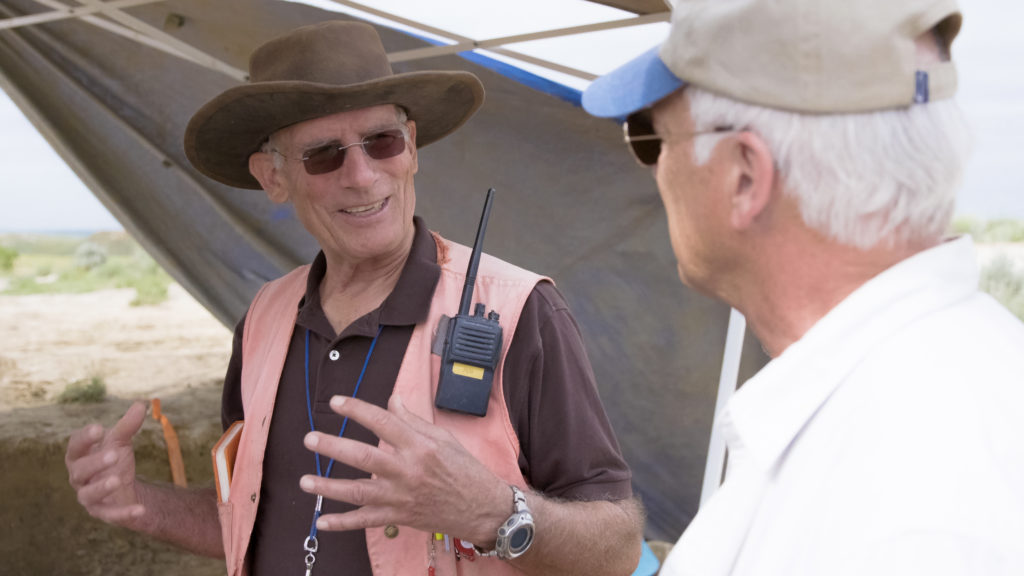
“The only way I know how you could develop a graded bed is if you had a catastrophic process that transported these bones and laid them all in as a single event.”
– Art Chadwick, taphonomist, from https://isgenesishistory.com/10000-dinosaurs/
What kind of catastrophe could kill thousands of dinosaurs and other animals before burying them in a three to six foot-thick layer of mudstone over such a large area?
The Braided Streams That Weren’t
The HR Bonebed is just one segment of an extensive system of rock layers and fossil-rich deposits called the Lance Formation, which extends across much of Wyoming. Old-earth paleontologists believe it was largely laid down by a network of braided streams flowing calmly across a coastal floodplain.3 A braided stream is a network of multiple shallow river channels that diverge and rejoin around small, often temporary, islands (sort of like braided hair).
But this isn’t the type of environment where one would expect mega-catastrophes like the one responsible for the HR Bonebed. To solve the mystery of what happened to Hanson Ranch’s dinosaurs, Dr. Snyder’s team had to think bigger than the HR Bonebed. Much bigger, in fact. Hanson Ranch is not the only hadrosaur-dominated bonebed; others have been identified in Canada,4 up in Alaska,5 and even all the way in Russia.6
In taphonomy, the sediment containing the fossils can give just as much insight into the cause of death and/or burial of fossil organisms as the fossils themselves. Sometimes even more so.
When the Earth Shakes
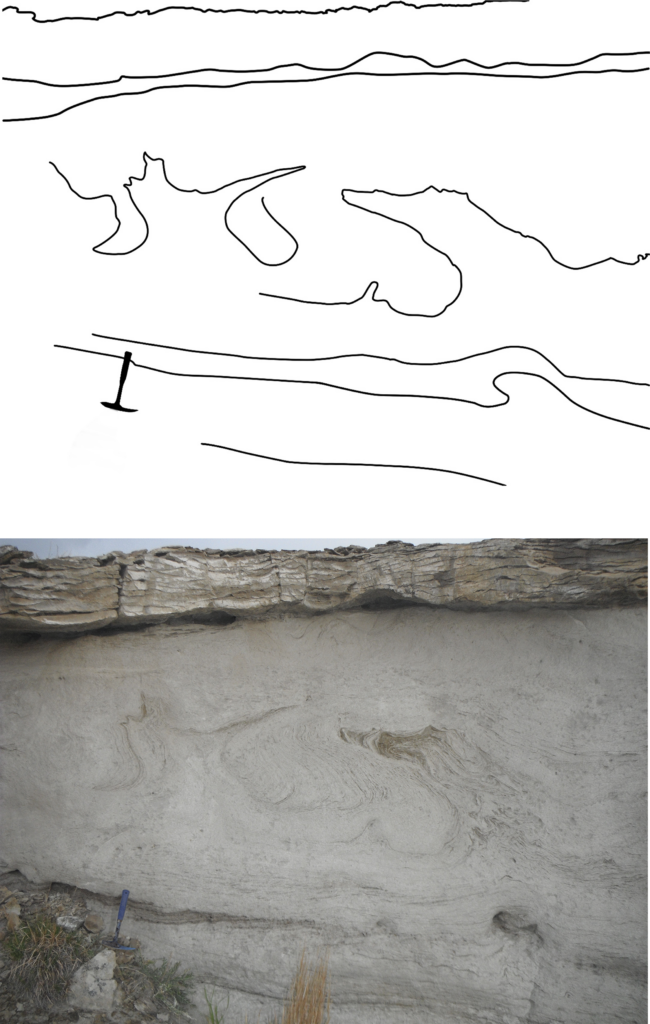
Many of the layers making up the Lance Formation consist of sandstone. This is not unusual. What is unusual is that the sandstone layers are embedded with unusual swirly patterns called seismites. These occur when an earthquake causes water within the sediment to deform the layers. Geologists use the thickness of a seismite to estimate the power of the earthquake that created it. The deformed layers of sandstone in the Lance Formation are quite thick, some measuring over 15 feet in thickness! To put this into perspective, a 5.5 magnitude earthquake might leave behind a seismite one inch in thickness.7 Clearly, the seismites in the Lance Formation were formed by earthquakes hundreds or thousands of times more powerful than any known from recent history. You likely would have felt it no matter where you stood on the continent of North America.
The Impact of These Impacts
We can learn two very important facts from studying the Lance Formation seismites. First, the layers of deformed sediment were still waterlogged by the time the earthquake appeared. This means these very thick layers must have formed relatively quickly, otherwise the layer would have become too dry and rock hard to deform. Second, the Lance Formation endured dozens of similarly-sized earthquakes in rapid succession around the time the HR Bonebed laid down. Scientists generally attributed such huge earthquakes to the impact of an asteroid or comet, but there is only evidence for one such impact at the top of the Lance Formation, called the Chicxulub impact. What of the other earthquakes that occurred earlier? A more likely scenario is that the movements of the earth’s tectonic plates caused these earthquakes, perhaps the same movements that formed the Rocky Mountains.
In-depth study of the orientation of fossils and the evidence of water current direction in the sediment entombing them offered additional information. Dr. Snyder and his team concluded that the Edmontosaurus did not die in their current burial place. Water (likely in the form of an underwater debris flow) transported their carcasses in an easterly direction to their final resting place.
With these pieces of data, we can begin to understand what catastrophic events took place that formed the bonebed now preserved at Hanson Ranch. This cataclysm was of a scale unprecedented in the modern world, but it fits very nicely with what we might expect to have resulted from a global Flood like the one described in the Book of Genesis, chapters 6-9.
A Different Sort of Flood
The Hanson Ranch Bonebed presents clear evidence of a catastrophic event on par with the Genesis Flood. But among this evidence are two pieces of data that, on the surface, seem to contradict this explanation.
Time Before Burial
First, the fossils preserved at Hanson Ranch Bonebed do not appear to have been instantly buried upon death. Rather, there was a period of time that passed between their death and burial.
As mentioned before, most of the dinosaur bones were disarticulated. In order for this to happen, the dead dinosaurs would have needed sufficient time for their skin, tendons, and ligaments that connected the bones in life to rot away. This process alone would have taken weeks or months.
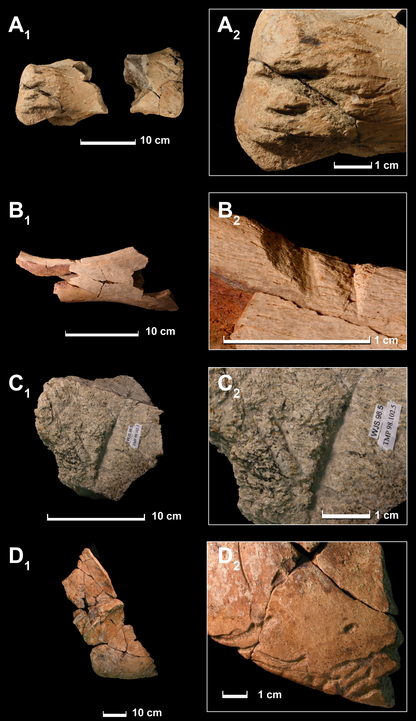
Second, most fossils of theropods, such as dromaeosaurs, troodontids, and Tyrannosaurus, found at Hanson Ranch are not bones, but shed teeth. Like sharks and alligators, theropods would frequently lose teeth when they became old and worn while feeding and fighting, allowing new teeth to grow in their place. We know the Hanson Ranch theropods were feeding on the Edmontosaurus carcasses not only from the shed teeth, but also the gnaw marks on 4% of the bones themselves. Another noteworthy observation is that many of the Edmontosaurus remains are broken in such a way that they were likely trampled, perhaps by the hungry theropods that were feeding on them.
If the Hanson Ranch dinosaurs died in the Flood, what catastrophe transported and buried their bones in their current location after they had time to decay and get gnawed on by scavengers?
Together, these two problems do not seem compatible with the typical understanding of the global Flood as held by most people. But perhaps the real problem lies not with the global Flood scenario itself, but our common mischaracature of it.
The Sunday School ‘Fable’
According to the story we were all told in Sunday school, the Flood instantly and wholy inundated the planet and lasted 40 days and 40 nights. However, a closer look at Scripture conveys a far more dynamic sequence of events than this mere children’s fable.
On the contrary, Noah and his family were on the Ark for an entire year or so. But the floodwaters did not completely submerge the Earth for the entirety of this time. The Genesis account breaks up the Flood narrative into several different phases, each different from the ones that came before or after. We should avoid the conflation of these phases, as doing so can severely muddy our understanding of what really happened during the Flood and the types of evidence we can expect it to have left behind.
The Phases of the Flood
The Flood commenced with the “breaking up of the fountains of the great deep” and the “opening of the windows of heaven,” which corresponds to torrential rain (Genesis 7:11-12). This “breaking up” resulted in the flooding of the dry land by ocean waters. Total (global) coverage of the earth’s land masses with water occurred at some point during the Flood (Genesis 7:19), causing the death of all land-dependent animal life not aboard the Ark (Genesis 7:21). Psalm 104:8 indicates that at the end of the Flood, mountains rose up and the waters returned to the valleys (ocean basins). After this, three more months pass and the Bible does not record the Flood’s end until Genesis 8:18, when Noah, his family, and the animals disembark from the Ark.
Geologic evidence left behind during the initiation phase of the Flood will differ significantly from any formed during the global inundation phase or the receding phase of the Flood. So at what stage during the Flood did the Hanson Ranch Bonebed form?
In the Wake of Receding Waters
To better understand when the Hanson Ranch Bonebed may have formed, we must consider its wider geological context. A study by geologists Dr. John Whitmore and Paul Garner looking at the geologic record of Wyoming observed that fossil-bearing rock layers below the Lance Formation are almost exclusively marine deposits, containing the preserved remains of sea-dwelling creatures.8 The rock layers above the Lance Formation, however, seem to be of terrestrial origin. They contain almost exclusively land or freshwater animals and plants buried in deposits of localized scope right up to the present day. The Lance Formation is different from either of these two extremes. While it does contain some marine deposits, it also contains others that seem to be more land-based. The Lance Formation, then, seems to represent an in-between stage between the two.
Other studies of the Lance Formation back this up. Based on her findings, researcher Rose Weeks suggested that the Hanson Ranch Bonebed, along with the rest of the Lance Formation, seems to have formed in a large delta or meandering river environment of a coastal plain.9 As the sea drained off the continent, the landscape was transformed from a marine environment into a terrestrial one.
Applied to HR Bonebed
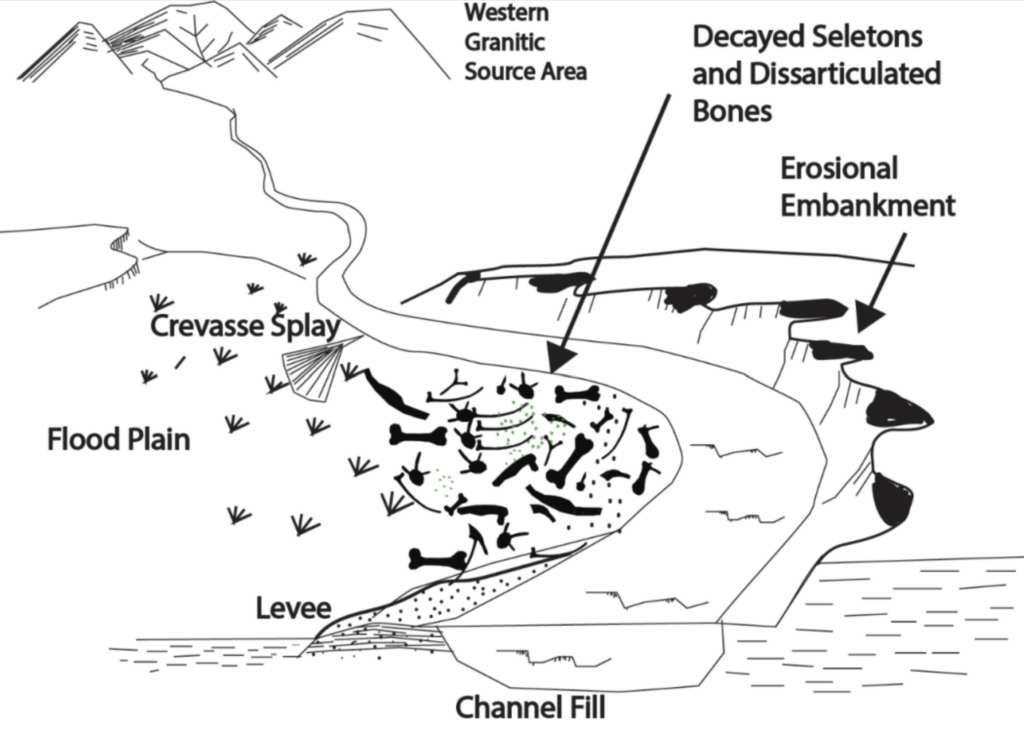
deposition of dinosaur bones.
Based on the biblical and geologic evidence, Whitmore and Garner think the Hanson Ranch Bonebed formed toward the end of the Flood. The account of the sending out of the raven and dove of Genesis 8 gives the impression that the floodwaters receded gradually from the land’s surface. In contrast to its erruptive onset, the end of the Flood seems to have been a much more gradual affair, perhaps occurring over a period of years.
As it happens, the disappearance of the sea and the emplacement of the Lance Formation coincide with the rise of the Rocky Mountains to the west. This caused catastrophic earth movements, leading to the formation of delta and river deposits across what is now Wyoming, along with the remains of thousands of dinosaurs they preserved.
How Did the Hanson Ranch Bonebed Form?
Taking the above information into account, Dr. Snyder and his team were able to lay out a tentative sequence of events that starts with the sudden death of the Hanson Ranch dinosaurs and ends with their burial in present-day Wyoming.
Somewhere west of modern-day Wyoming, one or more large herds of Edmontosaurus annectens (along with other animals) were the victims of a catastrophic scenario in the early stages of the global Noahic Flood, possibly drowning. A period of time followed during which they may have bloated and floated in the water before washing up and accumulating along a nearshore environment. The bodies didn’t remain undisturbed for long. The stench of rotting flesh soon attracted tyrannosaurs, raptors, troodontids, and small mammals, all drawn to the site by the prospect of an easy meal. The Edmontosaurus carcasses rotted in place for weeks or months, long enough for the flesh and ligaments to decay, but not so long that the bones became abraded or weathered.
Sometime later, a very large earthquake, catastrophic flooding, or very likely both, transported the dead animals that remained in a slurry of bones and muddy sediment called a debris flow. Since the bones remained in excellent condition during their journey, Snyder and his team believe that the slurry must have been highly viscous. The debris flow ended its journey in Wyoming, where it dumped the bones and sediment to form the graded bed that now exists at Hanson Ranch today.
Conclusion
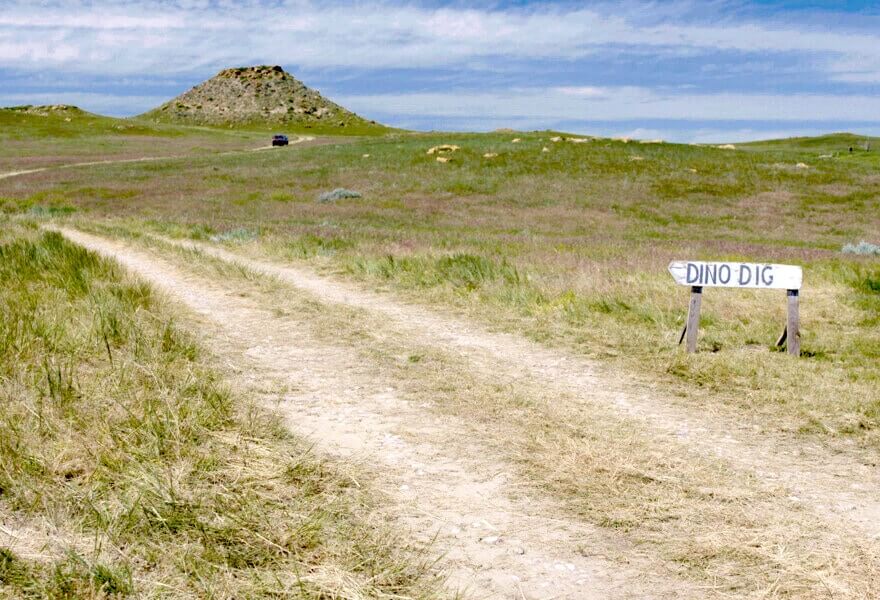
The Hanson Ranch Bonebed is an eyeopener. It provides us with incredible insight into what the world was like during the global Flood of Noah’s day. This wasn’t the happy-go-lucky fairytale of a 40-day/40-night rainstorm and a cute bathtub-shaped ark stuffed with smiling, cheery animals. This historic, cataclysmic event served as judgement upon a world wrought with mankind’s wickedness and the violence of both man and beast that then existed and perished (2 Peter 3:6).
Learn More about the Hanson Ranch Bonebed
Footnotes:
- Snyder, K., McLain, M., Wood, J. and Chadwick, A., 2020. “Over 13,000 elements from a single bonebed help elucidate disarticulation and transport of an Edmontosaurus thanatocoenosis.” Plos one, 15(5), p.e0233182. ↩︎
- Chadwick, Art & Spencer, Lee & Turner, Larry. (2006). “Preliminary depositional model for an upper cretaceous Edmontosaurus bonebed.” Journal of Vertebrate Paleontology. 26. 49A-49A. ↩︎
- S. R. Weeks, Depositional Model of a Late Cretaceous Dinosaur Fossil Concentration, Lance Formation, MS Thesis, Loma Linda University, Loma Linda, California, 2016 ↩︎
- Bell, P. R., & Campione, N. E. (2014). “Taphonomy of the Danek Bonebed: a monodominant Edmontosaurus (Hadrosauridae) bonebed from the Horseshoe Canyon formation, Alberta.” Canadian Journal of Earth Sciences, 51(11), 992-1006. ↩︎
- Gangloff, R. A., & Fiorillo, A. R. (2010). “Taphonomy and paleoecology of a bonebed from the Prince Creek Formation, North Slope, Alaska.” Palaios, 25(5), 299-317. ↩︎
- Lauters, P., Bolotsky, Y. L., Van Itterbeeck, J., & Godefroit, P. (2008). “Taphonomy and age profile of a latest Cretaceous dinosaur bone bed in far eastern Russia.” Palaios, 23(3), 153-162. ↩︎
- Austin, S.A., 2012, November. Jerusalem earthquake of 33 AD: evidence within laminated mud of the Dead Sea, Israel. In 2012 GSA Annual Meeting in Charlotte. GSA. ↩︎
- Whitmore, J. H. and Garner, P. (2008). “Using Suites of Criteria to Recognize Pre-Flood, Flood, and Post-Flood Strata in the Rock Record with Application to Wyoming (USA),” Proceedings of the International Conference on Creationism: Vol. 6, Article 35. ↩︎
- Weeks, 2016, (Ref. 3). ↩︎

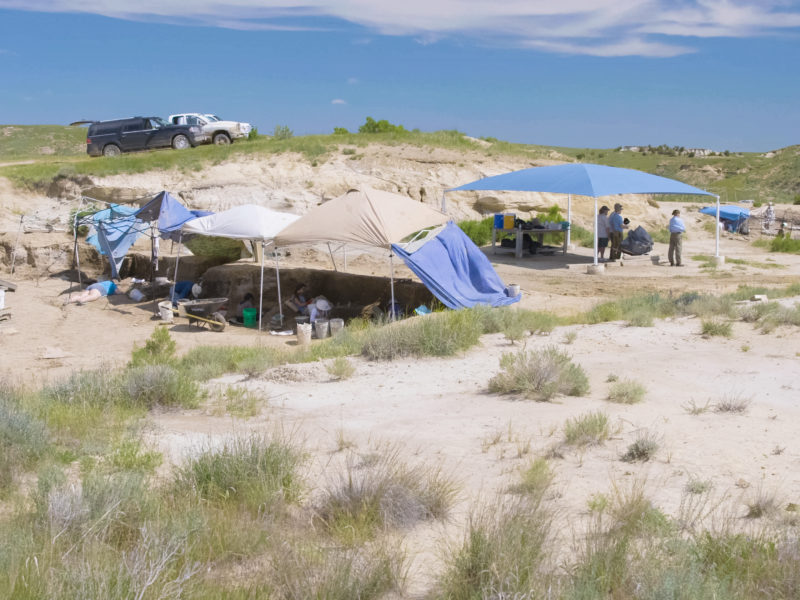











[…] Hanson Ranch, waar onder leiding van dr. Arthur Chadwick de Lance Formation ontsloten wordt.5 “Ze gebruiken hier de modernste apparatuur en technologie om de mysteries te ontrafelen die […]
Excellent article in making a case. Great info and then great interp[retation. its just a killer great point these were collected suddenly, thus a spectrum of ages and not old age, So persuasive of the even obvious fact that all these types of fossils only could come from water sourced depopsition. then its universal nature equals a universal event. Fitting in with the witness. The bad guys must smell a problem. Well done.
I live in the area. Is there any chance I could help with any of the digs?
Hi Sharon!
I just spent some weeks in June digging at the Hanson Ranch. There are dozens of volunteers that come out each year to participate! Check out https://dinosaur.swau.edu/project/ for more information on the project.
Noel
The scenario presented here depends on the idea that is “Contrary to popular belief” about the flood, and that “there is no scriptural evidence that the floodwaters covered the entire earth’s surface throughout the entire duration of the Flood.”
It rather depends on what you mean by the “Flood”. And yes I would agree that the entire earth’s surface was not covered for the entire duration of the flood; i.e. from the time the rain started, up until the new land surface was dry enough for Noah to leave the ark.
However, your article seems to contradict a straightforward reading of Genesis 7v17 to 20:
For forty days the flood kept coming on the earth, and the waters rose and lifted the ark high above the earth. So the waters continued to surge and rise greatly on the earth, and the ark floated on the surface of the waters. Finally, the waters completely inundated the earth, so that all the high mountains under all the heavens were covered. The waters rose and covered the mountaintops to a depth of fifteen cubits.
We are also told that all land animals outside of the ark perished and the waters prevailed for 150 days.
These verses seem to indicate that it took 40 days for a rather violent flood (mabbul) to completely cover the earth to a minimum depth of 15 cubits. And that these flood waters persistent for 150 days, before a decline started. This normal reading of the text is inconsistent with the idea that any land animals survived beyond the first 40 days.
TODAY’S SCIENTIST IS LOOKING AT THE AFTERMATH WITH NO REAL IDEA OF WHAT EXISTED BEFORE THIS CATACLYSM OCCURRED…SINCE WE WERE NOT THERE DECIPHERING THE LEFT OVERS IS A GARGANTUAN TASK WITH VERY LITTLE ROOM FOR SUPPOSITION. WE DO NOT KNOW IF OR HOW MANY TIMES CURRENTS CHANGED UNCOVERING REMAINS, TRANSPORTING THEM TO ANOTHER SITE FOR REBURIAL…Gen 7:17-23
Now the flood was on the earth forty days. The waters increased and lifted up the ark, and it rose high above the earth. 18 The waters prevailed and greatly increased on the earth, and the ark moved about on the surface of the waters. 19 And the waters prevailed exceedingly on the earth, and all the high hills under the whole heaven were covered. 20 The waters prevailed fifteen cubits upward, and the mountains were covered. 21 And all flesh died that moved on the earth: birds and cattle and beasts and every creeping thing that creeps on the earth, and every man. 22 All in whose nostrils was the breath of the spirit of life, all that was on the dry land, died. SINCE SCRIPTURE STRONGLY IMPLIES THAT THE WATERS ROSE ABOVE THE MOUNTAINS INDICATES TO ME THAT IT COVERED THE WHOLE EARTH…WHAT EVER THE SCRIPTURES SAY I BELIEVE HAPPENED FOR HE WHO BROUGHT ABOUT THIS CATASTROPHE WAS ALSO ITS WITNESS AND COMMUNICATED SUCH TO MOSES WHO IS THE CHOSEN OF GOD TO RECEIVE AND RECORD THIS INFORMATION…I THINK YOUR WORK IS AMAZING AND PROFITABLE BUT DO NOT GO FURTHER THAN THE CURRENT EVIDENCE WILL ALLOW…GOD BLESS AND MAY HE LEAD YOU TO ALL TRUTH…!!!
Genesis 7:19-20.The flood did cover the earth. Your idea that it did not is shown in this text to be incorrect.
I think you and I and the author all agree on a world wide flood. The flood would not have been all in one day though. During the first few days, the rains would cause heavy local flooding. After the rains all stop then it would take time for the water to dry up and some areas would dry first. Then if there were the earthquakes and more mountains forming, you could have the flood waters moving or more heavy local flooding.
I believe I have much the same and theory or possible conclusion to much geological confusion but requires seeing the extraordinary out of the presumed ordinary and yet no Archaeologist contacted has stepped out of the box to even the possibilities
The Bible is One, Single, Solitary book –
and that is the total extent of your evidence to prove your god???
The Bable book is only a ‘historical novel’
Fables within historical settings and with real people of history:
Pharaohs and Egypt did exist; Moses and the ‘exodus’ never happened in reality!
A ‘global’ flood never occurred in Geologic history!
Bable origins:
http://churchandstate.org.uk/2016/08/the-bibles-ungodly-origins/?fbclid=IwAR2JRp-A4xWvGwKcHBTYJN0wAWjz_7UGmi567nDd5NprxTS3Ceps2F7BMDs
Hello Brien,
Though we respectfully disagree with your position, I appreciate that you have taken the time to read my article. We at New Creation disagree with your assertion that the Bible is “One, Single, Solitary book,” and you would be hard-pressed to find a Bible scholar (Christian or otherwise) who would classify the entire thing is a “historical novel.” The Bible is actually a compilation of 66 books written over the course of 1,500 years by a myriad of different authors, including fishermen, generals, kings, prophets, scholars, a tax-collectors, and even a doctor. In addition, the Bible contains a variety of genres as well, including biography, instruction, poetry, romance, theology, and yes, history.
Please check out the following resources for more information on the global Flood and the Exodus:
Who Was the Pharaoh of the Exodus?
An Egyptian Perspective on the Plagues?
Why Don’t We See Evidence for Biblical Events?
The Role of Tsunamis in the Flood
Hanson Ranch Bonebed… what a magnificent find concerning the Noahic flood to the glory of God’s Word! It never ceases to amaze me that these kinds of evolution-shattering discoveries are always met with angry responses by God-hating, Bible-bashing people. It’s almost as if they know the truth, but just can’t accept it. The great delusion: People of science rejecting the very scientific evidence brought before them in their pathetic efforts to salvage foolish and nonsensical theories like Big Bang and life evolving from a primordial soup of nonliving constituents. We all recognize the illusion of a magician pulling a live rabbit out of an empty hat; yet some of us believe the entire Cosmos was born out of nothing! It boggles the mind! Nothing will convince an evolutionist of the Noahic flood—not even the greatest monument to such a recent Earth catastrophe—the Grand Canyon. Whatever one’s worldview, this article is without a doubt a magnificent refutation of the millions of years argument for a very old Earth.
Appreciate your explanation that provides a more detailed segment of the broader Genesis Flood and how one might interpret what is found.
Thank you, Larry! We appreciate the feedback. 🙂
Forgive me, as it might have gone over my head, but I didn’t see any mention of the condition of the bones as if there was soft tissue present. Soft tissue would indicate a young earth and a rapid burial, hence death as in being covered by heavy or thick layers of sediment consistent with the flood in Noah’s time, wouldn’t it?
Hello Teena,
Thank you for taking the time to read my article! While discoveries of original, organic material have been found in an increasing number of fossilized dinosaur remains, there have not (yet) been any reported in those found at the Hanson Ranch Bonebed, to my knowledge. It’s important to remember that while the presence of soft tissue in dinosaur bones can indicate that they are not millions of years old, the absence of soft tissue does not necessarily mean that the dinosaur bones are millions of years old. How much or how little original organic material is left in the bones is based on the conditions of burial and/or the environment in which they are preserved in. As such, sometimes fossilization can happen so quickly that little (if any) original, organic material remains. There is a fascinating phenomena called the Medusa Effect, where certain once-living organisms appear to have been fossilized instantaneously upon death; in fact, this might have even been the cause of their death.
Why weren’t the dinosaurs, T-Rex and others, that feasted on the Edmontosaurus also drowned in the flood?
Greetings, Glenn! Not all land-dependent animals died at the same time during the Flood. According to the current hypothesis, the Edmontosaurus herd(s) preserved in the Hanson Ranch Bonebed likely met their demise earlier in the Flood. They probably perished before the floodwaters completely inundated the dry land. Subsequently, their remains washed up along a shoreline, undergoing decay for weeks or months while other dinosaurs scavenged upon them. Later, potentially as the floodwaters receded, these bones were finally transported in an underwater debris flow that buried them where we find them today.
What part of scripture is “the current hypothesis” based on?
Scripture outlines a general timeline of events, stating God’s purpose for the Flood as the destruction of all land-dependent creatures on dry land (Genesis 6:7, 17; 7:21-23). While it doesn’t explicitly specify the precise point during the Flood when the last of these creatures perished, it provides a framework from us to begin working with. To fill in the missing puzzle pieces, we can turn to the geologic record that contains the fossils for clues. Analyzing the rock layers containing the fossils has allowed us to develop a plausible hypothesis that aligns with the available scientific and biblical data, as well as helping us better understand the sequence of events at play here.